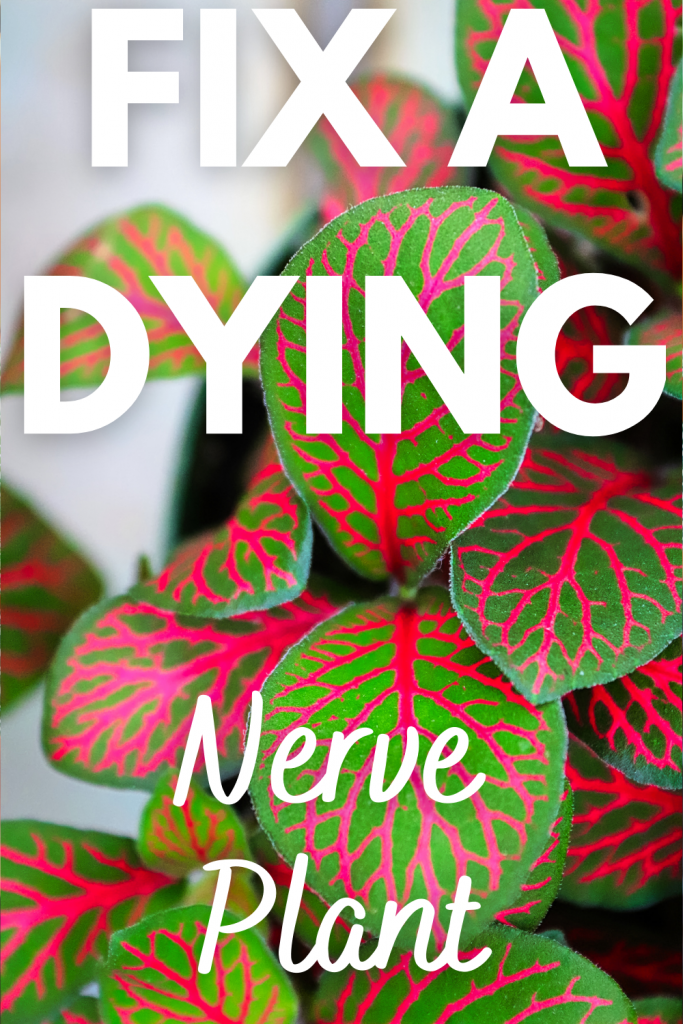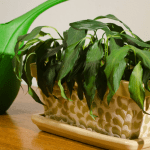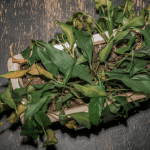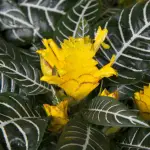
The first time I laid eyes on Nerve Plant (Fittonia), I had to have it for my indoor garden. We brought home the beautiful silvery-white, tropical plant in a hanging basket. We soon discovered that the plant required a lot of attention to prevent drooping. Here’s how to save a drooping nerve plant.
Water it. Fittonia will droop significantly if you let it get too dry. Other causes include low light, improper temperatures, and dry air. In fact, lack of water, low humidity, drafts or high temperatures, and exposure to direct sunlight are the most common reasons that this plant doesn’t thrive.
I was horrified the first time I walked into my kitchen – where my nerve plant lives – and saw the leaves limp and drooping over the sides of the pot. Luckily, it was an easy fix. The plant is quite hardy and will usually bounce back if you fix the problem quickly.
Just follow these four steps:
- Water thoroughly
- Move to a more (or less) sunny spot
- Increase humidity
- Provide proper temperatures
Step #1 – Water Thoroughly
Every single time my nerve plant gets droopy, it’s because it needs water. If I miss a watering, the plant lets me know
– big time! As a tropical plant native to rain forests, Fittonia needs a lot of moisture – through moist soil and high humidity. It even thrives as a terrarium plant.
Nerve plant is famous for collapsing any time the roots don’t supply the succulent stem with enough water. If you’ve noticed your plant has collapsed, water immediately. Dehydration for more than a few hours can be fatal to nerve plant. But if you water it in time, it should bounce back with no problems.
How much water does it need? That depends on the conditions in your home. But as a rule, check your nerve plant every day by touching the top of the soil. It should be moist to the touch, but not completely saturated with water. If it feels even slightly dry, add more water. Again, being careful not to overwater.
I typically water my nerve plant every day or every other day during the summer months – and two or three times a week during the winter. This seems to work best for my environment. You may have to experiment with your plant to see what works best. Yellowing leaves can indicate overwatering, so keep an eye out.
Ensure you have a well-draining potting soil in case you accidentally water too much. Never allow your plant to stand in water. Keep a moist potting mix – but never wet or soggy.
After watering a drooping nerve plant, give it a few hours or even overnight to return to its normal shape. If it doesn’t perk up, move on to the next steps.
Related: How to Tell if a Plant is Overwatered or Underwatered
Step #2 – Move to an (More or Less) Sunny Spot
If watering alone doesn’t fix your plant, you may have chosen a poor location for it to live. Nerve plant is very picky about the light it needs. It will not tolerate direct sunlight or too little light. For the best results, place nerve plant in an east- or west- facing window that gets a lot of bright, indirect light.
If you must place your plant in a south-facing window, set it back a few feet to shield it from direct sunlight and/or place a sheer curtain over the window to filter the light.
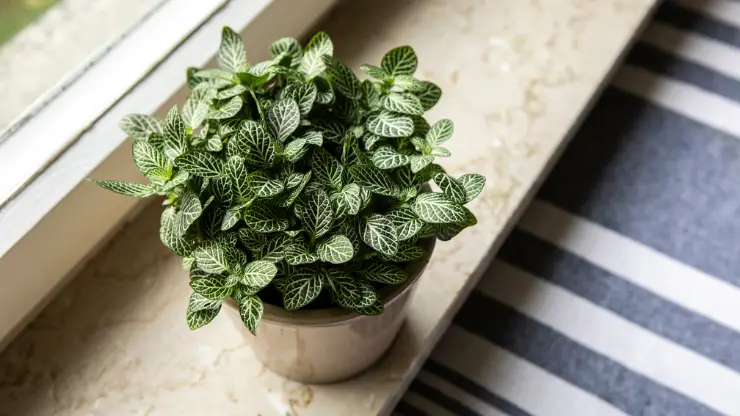
If you’re growing in low light conditions, consider supplementing with fluorescent lights. When we first got our nerve plant, we put it in a shady window in the kitchen just above the sink. It wasn’t doing too well after a few weeks (and I know it wasn’t due to lack of humidity).
We installed a fluorescent light in the top of the window. I leave it on during the day while I’m working, and my tropical indoor plants LOVE it. This is a great supplement if you only have a low to medium light location available for your plant.
I know that sounds like a lot of work, but it’s really not. We bought this inexpensive light from Amazon and my husband installed it in the top of the window. It has a timer and settings for brightness, different types of light, etc. Our nerve plant has never been happier. You can also read our in-depth review of the best indoor plant lights on this page.
Step #3 – Increase Humidity
As a tropical plant, Fittonia needs high humidity levels. If the air gets too dry, the leaves may droop and appearance may decline. Nerve plant is sometimes considered difficult to grow because of its high moisture and humidity requirements.
If treated like an ordinary houseplant placed in a pot on a table or in a windowsill, Fittonia tends to react badly to the dry air found in most homes. Many people prefer to grow it in a terrarium because it’s easier to keep the humidity high. But it’s not impossible to grow in a pot. That’s how we grow ours.
You can do any or all the following to increase the humid environment around your plant:
- Mist daily with a handheld mister or use a spray bottle of water on the “mist” setting. This teqhnique works great for humidity loving plants like fittonia.
- Place the pot on a tray filled with pebbles and water – making sure the bottom of the pot sits on the pebbles and doesn’t actually touch the water. See my post on how to make a humidity tray for your houseplants if you don’t know how!
- Place a room humidifier near the plant. We prefer to put our nerve plant as close to the humidifier as possible, since it needs more humidity than almost any other plant we own.
- Place near other plants with high humidity requirements. When you mist them all together, they can share humidity and keep the levels higher.
Click here to see our favorite plant humidifier on Amazon. This thing works wonders and is easy to clean. We leave it running in our living room – where most of our plants live. It keeps the relative humidity at 40 – 60 percent, which is perfect for nerve plant and other tropical plants.

If you keep a humid environment and water regularly, we’ve not found nerve plant difficult to keep healthy and beautiful. Maybe not as easy as a snake plant, but not too hard either. It mostly just needs a lot of love and attention.
#4 – Adjust Temperatures
Nerve plant performs best in average room temperatures with high humidity levels. If temperatures drop too low, the plant may droop, develop leaf drop, and just generally perform poorly. Maintain a temperature range between 65 – 75 degrees F (18 -24 degrees C) at all times.
Also, make sure to keep your nerve plant in a place where it doesn’t get blasted with cold air from opening doors, air conditioning vents, etc. Fluctuations in temperature due to drafts can also cause a drooping nerve plant (but not to the extent that under-watering or low humidity will).
Remember, nerve plant is native to the tropical rainforests of South America. The forest floor where it lives is cool, damp, and moist. Try to recreate the same conditions found in its natural habitat in your home, and you’ll have a thriving plant in no time!
How to Save a Drooping Nerve Plant
Like many other indoor plants, nerve plants can’t tolerate drying out or cold temperatures. The most common reason for a drooping nerve plant is lack of moisture. When grown indoors, keep a close eye on the plant’s soil moisture. Water any time it begins to droop or the soil feels dry.
If you fix the situation quickly, your plant should recover and spring back to health. If you let nerve plants remain droopy for too long, they may not recover. So make sure to address the problem as soon as you can. Fittonia has a reputation of being finicky, but I’ve found it’s not that hard if you try!
Related Questions
How do you water nerve plant? Apply room temperature water directly to the soil. For the best results, use a watering can with a long, small spout to reach below the leaves. Water evenly and always keep the soil moist – but never wet. Don’t allow the plant to stand in water or become waterlogged. Make sure water is not too hot or too cold to prevent shocking the roots.
Why is Fittonia called nerve plant? The bright veins – which can be silver, white, light green, or bright pink – look like nerves running through the plant’s dark green leaves. This unique appearance led to Fittonia’s common name of nerve plant. It’s a gorgeous, tropical houseplant prized for its foliage.

